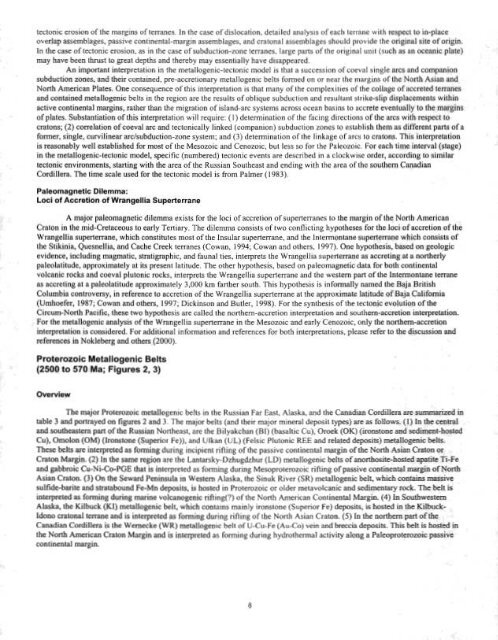Metallogenesis and Tectonics of the Russian Far East, Alaska, and ...
Metallogenesis and Tectonics of the Russian Far East, Alaska, and ...
Metallogenesis and Tectonics of the Russian Far East, Alaska, and ...
You also want an ePaper? Increase the reach of your titles
YUMPU automatically turns print PDFs into web optimized ePapers that Google loves.
tectonic erosion <strong>of</strong> <strong>the</strong> margins <strong>of</strong> terranes. In <strong>the</strong> case <strong>of</strong> dislocation, detailed analysis <strong>of</strong> each terrane with respect to in-place<br />
overlap assemblages, passive continental-margin assemblages, <strong>and</strong> cratonal assemblages should provide <strong>the</strong> original site <strong>of</strong> origin.<br />
In <strong>the</strong> case <strong>of</strong> lectonic erosion, as in <strong>the</strong> case <strong>of</strong> subduction-zone terranes, large parts <strong>of</strong> <strong>the</strong> original unit (such as an oceanic plate)<br />
may have been thrust to great depths <strong>and</strong> <strong>the</strong>reby may essentially have disappeared.<br />
An important interpretation in <strong>the</strong> metallogenic-tectonic model is that a succession <strong>of</strong> coeval single arcs <strong>and</strong> companion<br />
subduction zones, <strong>and</strong> <strong>the</strong>ir contained, pre-accretionary metallogenic belts formed on or near <strong>the</strong> margins <strong>of</strong> <strong>the</strong> North Asian <strong>and</strong><br />
North American Plates. One consequence <strong>of</strong> this interpretation is that many <strong>of</strong> <strong>the</strong> complexities <strong>of</strong> <strong>the</strong> collage <strong>of</strong> accreted terranes<br />
<strong>and</strong> contained metallogenic belts in <strong>the</strong> region are <strong>the</strong> results <strong>of</strong> oblique subduction <strong>and</strong> resultant strike-slip displacements within<br />
active continental margins, ra<strong>the</strong>r than <strong>the</strong> migration <strong>of</strong> isl<strong>and</strong>-arc systems across ocean basins to accrete eventually to <strong>the</strong> margins<br />
<strong>of</strong> plates. Substantiation <strong>of</strong> this interpretation will require: (1) determination <strong>of</strong> <strong>the</strong> facing directions <strong>of</strong> <strong>the</strong> arcs with respect to<br />
cratons; (2) correlation <strong>of</strong> coeval arc <strong>and</strong> tectonically linked (companion) subduction zones to establish <strong>the</strong>m as different parts <strong>of</strong> a<br />
former, single, curvilinear arc/subduction-zone system; <strong>and</strong> (3) determination <strong>of</strong> <strong>the</strong> linkage <strong>of</strong> arcs to cratons. This interpretation<br />
is reasonably well established for most <strong>of</strong> <strong>the</strong> Mesozoic <strong>and</strong> Cenozoic, but less so for <strong>the</strong> Paleozoic. For each time interval (stage)<br />
in <strong>the</strong> metallogenic-tectonic model, specific (numbered) tectonic events are described in a clockwise order, according to similar<br />
tectonic environments, starting with <strong>the</strong> area <strong>of</strong> <strong>the</strong> <strong>Russian</strong> Sou<strong>the</strong>ast <strong>and</strong> ending with <strong>the</strong> area <strong>of</strong> <strong>the</strong> sou<strong>the</strong>rn Canadian<br />
Cordillera. The time scale used for <strong>the</strong> tectonic model is from Palmer (1983).<br />
Paleomagnetic Dilemma:<br />
Loci <strong>of</strong> Accretion <strong>of</strong> Wrangellia Superterrane<br />
A major paleomagnetic dilemma exists for <strong>the</strong> loci <strong>of</strong> accretion <strong>of</strong> superterranes to <strong>the</strong> margin <strong>of</strong> <strong>the</strong> North American<br />
Craton in <strong>the</strong> mid-Cretaceous to early Tertiary. The dilemma consists <strong>of</strong> two conflicting hypo<strong>the</strong>ses for <strong>the</strong> loci <strong>of</strong> accretion <strong>of</strong> <strong>the</strong><br />
Wrangellia superterrane, which constitutes most <strong>of</strong> <strong>the</strong> Insular superterrane, <strong>and</strong> <strong>the</strong> Intermontane superterrane which consists <strong>of</strong><br />
<strong>the</strong> Stikinia, Quesnellia, <strong>and</strong> Cache Creek terranes (Cowan. 1994; Cowan <strong>and</strong> o<strong>the</strong>rs, 1997). One hypo<strong>the</strong>sis, based on geologic<br />
evidence, including magmatic, stratigraphic, <strong>and</strong> faunal ties, interprets <strong>the</strong> Wrangellia superterrane as accreting at a nor<strong>the</strong>rly<br />
paleolatitude, approximately at its present latitude. The o<strong>the</strong>r hypo<strong>the</strong>sis, based on paleomagnetic data for both continental<br />
volcanic rocks <strong>and</strong> coeval plutonic rocks, interprets <strong>the</strong> Wrangellia superterrane <strong>and</strong> <strong>the</strong> western part <strong>of</strong> <strong>the</strong> Intermontane terrane<br />
as accreting at a paleolatitude approximately 3,000 km far<strong>the</strong>r south. This hypo<strong>the</strong>sis is informally named <strong>the</strong> Baja British<br />
Columbia controversy, in reference to accretion <strong>of</strong> <strong>the</strong> Wrangellia superterrane at <strong>the</strong> approximate latitude <strong>of</strong> Baja California<br />
(Umhoefer, 1987; Cowan <strong>and</strong> o<strong>the</strong>rs, 1997; Dickinson <strong>and</strong> Butler, 1998). For <strong>the</strong> syn<strong>the</strong>sis <strong>of</strong> <strong>the</strong> tectonic evolution <strong>of</strong> <strong>the</strong><br />
Circum-North Pacific, <strong>the</strong>se two hypo<strong>the</strong>sis are called <strong>the</strong> nor<strong>the</strong>rn-accretion interpretation <strong>and</strong> sou<strong>the</strong>rn-accretion interpretation.<br />
For <strong>the</strong> metallogenic analysis <strong>of</strong> <strong>the</strong> Wrangellia superterrane in <strong>the</strong> Mesozoic <strong>and</strong> early Cenozoic, only <strong>the</strong> nor<strong>the</strong>rn-accretion<br />
interpretation is considered. For additional information <strong>and</strong> references for both interpretations, please refer to <strong>the</strong> discussion <strong>and</strong><br />
references in Nokleberg <strong>and</strong> o<strong>the</strong>rs (2000).<br />
Proterozoic Metallogenic Belts<br />
(2500 to 570 Ma; Figures 2, 3)<br />
Overview<br />
The major Proterozoic metallogenic belts in <strong>the</strong> <strong>Russian</strong> <strong>Far</strong> <strong>East</strong>, <strong>Alaska</strong>, <strong>and</strong> <strong>the</strong> Canadian Cordillera are summarized in<br />
table 3 <strong>and</strong> portrayed on figures 2 <strong>and</strong> 3. The major belts (<strong>and</strong> <strong>the</strong>ir major mineral deposit types) are as follows. (1) In <strong>the</strong> central<br />
<strong>and</strong> sou<strong>the</strong>astern part <strong>of</strong> <strong>the</strong> <strong>Russian</strong> Nor<strong>the</strong>ast, are <strong>the</strong> Bilyakchan (BI) (basaltic Cu), Oroek (OK) (ironstone <strong>and</strong> sediment-hosted<br />
Cu), Omolon (OM) (Ironstone (Superior Fe)), <strong>and</strong> Ulkan (UL) (Felsic Plutonic REE <strong>and</strong> related deposits) metallogenic belts.<br />
These belts are interpreted as forming during incipient rifting <strong>of</strong> <strong>the</strong> passive continental margin <strong>of</strong> <strong>the</strong> North Asian Craton or<br />
Craton Margin. (2) In <strong>the</strong> same region are <strong>the</strong> Lantarsky-Dzhugdzhur (LD) metallogenic belts <strong>of</strong> anorthosite-hosted apatite Ti-Fe<br />
<strong>and</strong> gabbroic Cu-Ni-Co-PGE that is interpreted as forming during Mesoproterozoic rifting <strong>of</strong> passive continental margin <strong>of</strong> North<br />
Asian Craton. (3) On <strong>the</strong> Seward Peninsula in Western <strong>Alaska</strong>, <strong>the</strong> Sinuk River (SR) metallogenic belt, which contains massive<br />
sulfide-barite <strong>and</strong> stratabound Fe-Mn deposits, is hosted in Proterozoic or older metavolcanic <strong>and</strong> sedimentary rock. The belt is<br />
interpreted as forming during marine volcanogenic rifling(?) <strong>of</strong> <strong>the</strong> North American Continental Margin. (4) In Southwestern<br />
<strong>Alaska</strong>, <strong>the</strong> Kilbuck (KI) metallogenic belt, which contains mainly ironstone (Superior Fe) deposits, is hosted in <strong>the</strong> Kilbuck-<br />
Idono cratonal terrane <strong>and</strong> is interpreted as forming during rifting <strong>of</strong> <strong>the</strong> North Asian Craton. (5) In <strong>the</strong> nor<strong>the</strong>rn part <strong>of</strong> <strong>the</strong><br />
Canadian Cordillera is <strong>the</strong> Wernecke (WR) metallogenic belt <strong>of</strong> U-Cu-Fe (Au-Co) vein <strong>and</strong> breccia deposits. This belt is hosted in<br />
<strong>the</strong> North American Craton Margin <strong>and</strong> is interpreted as forming during hydro<strong>the</strong>rmal activity along a Paleoproterozoic passive<br />
continental margin.
















